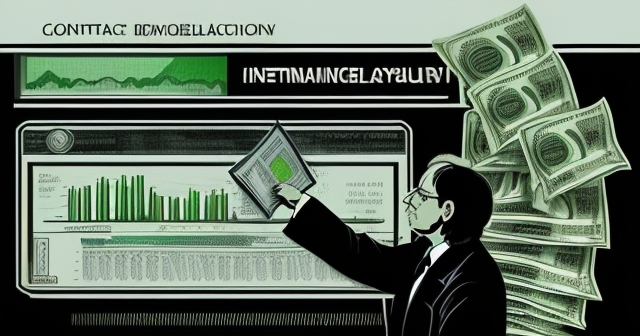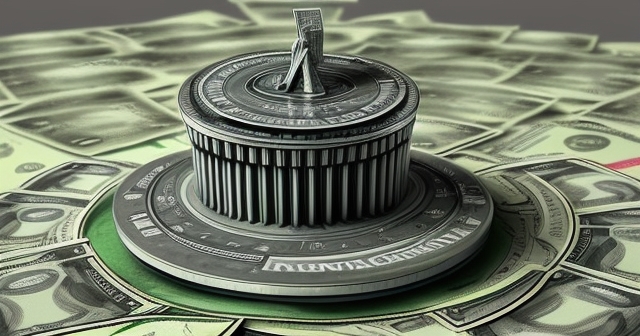
QE Definition: Understanding Quantitative Easing in Today’s Economy
Table of Contents
ToggleUnderstanding Quantitative Easing (QE): A Central Bank’s Powerful, Unconventional Tool
Imagine a country’s economy is like a vast machine, and the central bank is its chief engineer. This engineer has a primary tool – the interest rate – which they use to speed up or slow down the machine. Lowering rates makes borrowing cheaper, encouraging businesses and people to spend and invest, thus speeding up the economy. Raising rates does the opposite.
But what happens when the machine is stalled, perhaps during a severe recession, and the interest rate tool is already set as low as it can go, near zero? This is like the engineer pushing the accelerator to the floor, but the engine still isn’t revving. At this point, traditional monetary policy runs out of road. The central bank needs a different, more powerful tool. That tool is often called Quantitative Easing, or QE.
If you’re new to investing or looking to deepen your understanding of macroeconomics’ impact on markets, grasping QE is fundamental. It’s a concept that has dramatically shaped the financial landscape over the past couple of decades. Let’s break down what QE is, why central banks use it, and what its effects can be.

What Exactly is Quantitative Easing? Defining the Core Mechanism
At its heart, Quantitative Easing is an unconventional monetary policy where a central bank purchases a predetermined quantity of long-term government bonds or other financial assets from the open market. The key here is “unconventional” and “quantity.” Unlike traditional policy that targets a specific short-term interest rate, QE targets the amount of assets the central bank holds on its balance sheet.
Think of it this way: When the central bank decides to do QE, it’s essentially creating new money – not by printing physical bills, but by creating digital money in the form of central bank reserves. It then uses this newly created digital money to buy assets, primarily government bonds (like U.S. Treasuries or UK Gilts), but sometimes other assets like mortgage-backed securities (MBS) or even corporate bonds from institutions like commercial banks, pension funds, and investment firms.
When the central bank buys a bond from a commercial bank, the bank gives the central bank the bond, and the central bank credits the bank’s reserve account with new digital money. This increases the amount of money (reserves) that commercial banks hold at the central bank. It also adds a new asset (the bond) to the central bank’s balance sheet and removes an asset (the bond) from the commercial bank’s balance sheet, replacing it with reserves.
So, in simple terms, QE is about expanding the central bank’s balance sheet and injecting significant amounts of liquidity into the financial system by purchasing assets.

Why and When Central Banks Turn to QE: Beyond the Zero Lower Bound
As we mentioned, the primary reason central banks resort to QE is when their conventional tool – lowering the short-term interest rate – is no longer effective. This typically happens when the benchmark rate is already close to zero, a situation known as the zero lower bound (ZLB) or a liquidity trap. Once the rate hits zero, you can’t lower it further to stimulate borrowing and spending.
In such a scenario, the economy might still be struggling, perhaps facing a deep recession or, even worse, deflation (a sustained decrease in the general price level). Deflation is particularly feared by central bankers because it can create a vicious cycle: people postpone spending because they expect prices to fall further, which reduces demand, further lowering prices and economic activity. Businesses earn less, leading to layoffs, and the economy spirals downward.
QE is deployed to break this cycle and provide additional stimulus when traditional methods fail. Its main objectives are:
- Lowering Long-Term Interest Rates: While the central bank controls short-term rates, QE aims to influence longer-term rates, such as yields on 10-year government bonds or mortgage rates. By creating massive demand for these assets, the central bank bids up their prices. Since bond prices and yields move inversely, higher prices mean lower yields. These lower long-term yields serve as benchmarks for borrowing costs across the economy.
- Increasing Liquidity in the Banking System: By crediting banks with reserves, QE increases the amount of money banks have available. The hope is that banks will use this increased liquidity to lend more to businesses and consumers.
- Stimulating Lending and Investment: With lower borrowing costs and more reserves, banks should, in theory, be more willing and able to lend. Businesses are encouraged to invest in projects, and consumers to buy homes or cars, thereby boosting aggregate demand.
- Boosting Asset Prices (Wealth Effect): The cash injected into the financial system might not just sit in bank reserves. Institutions receiving this money might use it to buy other assets like corporate bonds, stocks, or real estate, pushing up their prices. Rising asset prices can make individuals and corporations who own these assets feel wealthier (the “wealth effect”), potentially encouraging them to spend more.
- Managing Inflation Expectations: By demonstrating a commitment to injecting money and stimulating the economy, the central bank tries to signal that it will prevent deflation and potentially bring inflation back towards its target. This can influence expectations and encourage current spending.
So, QE is a tool for emergencies – used when the economy is in dire straits and needs a significant, unconventional push to get moving again.
The Mechanics in Detail: How Asset Purchases Influence the Economy
Let’s delve a bit deeper into the chain reaction QE is designed to trigger. When the central bank announces a QE program, it specifies the amount and type of assets it intends to buy over a certain period. For example, the Federal Reserve might announce it will buy $120 billion of Treasury securities and mortgage-backed securities per month.
These purchases are made in the open market, meaning the central bank doesn’t buy directly from the government (which would be like financing government spending directly, a line central banks usually avoid), but from financial institutions that already hold these assets. These institutions include commercial banks, investment banks, insurance companies, pension funds, and hedge funds.
When the central bank buys a bond from, say, a commercial bank, two things happen on the commercial bank’s balance sheet:
- Its holdings of that bond decrease.
- Its reserves held at the central bank increase by the same amount.
These reserves are sometimes called “base money” or “high-powered money.” Commercial banks can potentially multiply these reserves through lending (the money multiplier effect, though this effect can be less predictable in modern finance than textbook examples suggest). More importantly, excess reserves held by banks don’t earn a high return, incentivizing banks to find more profitable uses for the money.
What can banks do with these increased reserves and the cash they received from selling bonds?
- Lend to each other: This typically happens in the interbank market. Increased reserves here can lower the short-term rates banks charge each other, reinforcing the central bank’s near-zero short-term rate policy.
- Lend to businesses and consumers: This is the critical transmission mechanism QE aims for. With more liquidity and potentially lower long-term funding costs (influenced by the now-lower bond yields), banks are hopefully more willing to extend credit.
- Buy other assets: If lending opportunities are limited (due to low demand or risk aversion), banks and other institutions that sold bonds to the central bank might use the cash to buy other financial assets, such as corporate bonds, stocks, or even property. This “portfolio rebalancing” effect pushes up the prices of these other assets.

This asset price inflation, particularly in equities and real estate, is a significant channel through which QE is thought to stimulate the economy (the wealth effect we mentioned) and encourage investment (making it easier for companies to raise capital by issuing stocks or bonds). It also lowers the cost of capital for businesses looking to expand.
Economic Effects: Stimulating Activity and Managing Expectations
The intended economic effects of QE are multifaceted, aiming to revive a sluggish economy from several angles:
- Lower Borrowing Costs: By driving down long-term bond yields, QE effectively lowers the cost of borrowing for governments, corporations (when they issue bonds), and households (mortgages, car loans). This makes large purchases and investments more affordable.
- Increased Lending: The injection of reserves is designed to ensure banks have ample liquidity and capacity to lend. The hope is that lower borrowing costs and increased capacity translate into more actual loans being made, fueling spending and investment.
- Currency Devaluation: Increasing the supply of the domestic currency (by creating reserves) can, under certain conditions, lead to its depreciation relative to other currencies. A weaker currency makes a country’s exports cheaper for foreign buyers and imports more expensive for domestic buyers. This can boost export-oriented industries and make domestic goods more competitive, adding to economic activity. However, this effect is complex and depends on the actions of other central banks and global capital flows.
- Inflation Expectations: By actively expanding the money supply and demonstrating a commitment to economic stimulus, central banks try to convince the public and businesses that inflation will not fall into negative territory (deflation) but will eventually return towards their target (e.g., 2%). Positive inflation expectations can prevent people from delaying purchases and encourage businesses to invest.
- Support for Asset Markets (Wealth Effect): We touched on this, but the boost to bond, stock, and property markets can make asset owners feel wealthier, potentially leading them to increase spending. Rising stock markets also make it cheaper for companies to raise equity capital for expansion.
It’s important to note that the success of these transmission mechanisms is not guaranteed. For instance, even if banks have plenty of reserves and borrowing costs are low, businesses and consumers might not borrow if they are pessimistic about the future or if demand for their products/services is weak. This is often cited as a limitation of QE – it can provide the fuel (liquidity), but it can’t force the car to drive if the driver (economy) isn’t willing or able.
Market Impacts: From Bonds to Stocks and Beyond
Quantitative Easing has a direct and profound impact on financial markets, beginning with the assets the central bank targets.
- Bond Markets: This is the most direct impact. As the central bank becomes a massive buyer of government bonds, demand surges. Increased demand for a fixed supply of existing bonds drives up their prices. Since a bond’s yield moves inversely to its price, bond yields fall. This effect is most pronounced in the types and maturities of bonds the central bank is buying, but it tends to ripple across the entire bond market as investors adjust their portfolios. Lower government bond yields reduce the benchmark rate used to price other forms of credit, like corporate bonds and mortgages, pulling those rates down as well.
- Equity Markets: The impact on stock markets is more indirect but often significant. The cash injected into the financial system from QE can flow into equities as investors and institutions look for higher returns than now-low bond yields. Furthermore, lower borrowing costs make it cheaper for companies to finance their operations and investments, potentially boosting profitability and thus stock valuations. The “wealth effect” also plays a role, as rising asset prices can increase investor confidence and risk appetite, leading to more investment in stocks.
- Property Markets: Lower long-term interest rates, particularly mortgage rates, make buying property more affordable. Combined with potentially increased liquidity in the system, this can fuel demand in the housing market and contribute to rising property prices.
- Currency Markets: As discussed earlier, increasing the supply of domestic currency through QE can put downward pressure on its exchange rate relative to other currencies, assuming other central banks are not undertaking similar policies simultaneously. This can lead to currency devaluation.

Understanding these market dynamics is crucial for investors. QE policies can lead to periods where “bad news is good news” for markets, because weak economic data might signal the central bank will continue or even increase stimulus, potentially further boosting asset prices. Conversely, signs of economic strength might lead markets to anticipate the withdrawal of QE, causing volatility.
As liquidity increases and market dynamics shift due to policies like QE, traders often look for platforms that can handle diverse instruments across different markets. If you’re considering exploring more CFD products or thinking about starting forex trading, then Moneta Markets is a platform worth considering. It’s based in Australia and offers over 1000 financial instruments, which can be useful for implementing various trading strategies in response to changing market conditions.
The Risks and Criticisms of Quantitative Easing: Is it a Panacea or a Pandora’s Box?
While QE is intended to be a beneficial tool for economic stabilization, it is not without significant risks and has attracted considerable criticism.
- Inflation: The most commonly cited risk is inflation. By significantly increasing the money supply, central banks run the risk of creating too much money chasing too few goods, leading to rising prices. This risk is particularly acute if QE continues for too long after the economy has recovered or if the central bank misjudges the economy’s capacity. Some critics argue that while QE didn’t immediately cause consumer price inflation after the GFC, it fueled asset price inflation (stocks, bonds, housing). More recently, QE during the COVID-19 pandemic, combined with fiscal stimulus and supply chain disruptions, has been linked to the global surge in inflation.
- Asset Bubbles: By driving down yields on safe assets like government bonds, QE pushes investors into riskier assets in search of yield, potentially inflating bubbles in stock markets, real estate, or other asset classes. When these bubbles burst, they can cause financial instability and economic damage.
- Increased Inequality: A major criticism is that QE disproportionately benefits those who already own financial assets and property (typically older, wealthier individuals) by increasing the value of those assets. It does less to directly boost the income or wealth of those who primarily rely on wages or who don’t own significant assets (often younger or lower-income individuals), potentially widening the wealth gap.
- Limited Lending (Credit Crunch): As mentioned earlier, QE increases bank reserves, but it doesn’t force banks to lend. If businesses and households are unwilling to borrow (low demand) or banks are unwilling to lend (high risk aversion, regulatory constraints), the money can get stuck in the banking system (“pushing on a string”), failing to stimulate the broader economy effectively.
- Moral Hazard: Some argue that QE creates moral hazard by bailing out financial markets and potentially discouraging governments and financial institutions from taking necessary, but painful, steps to fix underlying structural problems.
- Currency Devaluation Risks: While a weaker currency can help exports, it makes imports more expensive, potentially contributing to domestic inflation. It can also lead to international tensions if perceived as a deliberate attempt to gain a trade advantage (“currency wars”).
- Exit Strategy Challenges: Unwinding QE (Quantitative Tightening) presents its own set of challenges, which we will discuss shortly. The process can be complex and risky, potentially causing market volatility and raising borrowing costs too quickly, harming economic recovery.

These risks highlight that QE is not a risk-free solution but a powerful measure to be used cautiously and unwound carefully.
The Effectiveness Debate: Did QE Work?
Economists and policymakers widely debate the precise effectiveness of QE. It’s challenging to isolate the effects of QE from other economic factors and policy responses happening simultaneously, such as fiscal stimulus (government spending and tax policies).
Supporters argue that QE was crucial in preventing deeper recessions and outright deflation after the 2008 Global Financial Crisis and the COVID-19 pandemic. They point to stabilizing financial markets, lower borrowing costs, and preventing deflationary spirals as key successes. For example, studies on the Fed’s QE programs post-2008 generally conclude that they significantly lowered long-term interest rates and supported economic activity, although the magnitude of the effect is debated.
Critics acknowledge that QE likely helped stabilize financial systems but question its effectiveness in stimulating real economic activity, such as boosting employment or wages, particularly after the GFC. They argue that much of the injected liquidity ended up back in financial markets rather than flowing into the real economy through lending. The debate often revolves around whether the benefits were worth the risks, particularly concerning asset bubbles and inequality.
Different “rounds” of QE (QE1, QE2, QE3, etc., often referring to programs by the Fed or BoE) are often studied separately, as their economic contexts and design varied, leading to potentially different impacts. The consensus seems to be that QE is effective in times of extreme crisis for stabilizing financial markets and providing initial stimulus, but its power to create sustained, broad-based economic growth in the long run is less certain and subject to diminishing returns.
Global Experiences: QE in Practice (US, UK, Eurozone, Japan)
Quantitative Easing is not unique to any single country. Major central banks around the world have implemented large-scale asset purchase programs in response to economic crises:
- United States (Federal Reserve): The Fed undertook multiple rounds of QE starting in late 2008 in response to the Global Financial Crisis. These programs (QE1, QE2, QE3, and QE-infinity/tapering discussions) involved purchasing Treasury securities and mortgage-backed securities totaling trillions of dollars. QE was revived dramatically in March 2020 in response to the COVID-19 pandemic, with asset purchases reaching unprecedented levels.
- United Kingdom (Bank of England): The BoE also began its QE program in March 2009. It purchased government bonds (Gilts) and some corporate bonds. The program was expanded during the Eurozone debt crisis, following the Brexit vote, and significantly again during the COVID-19 pandemic. The BoE was among the first major central banks to start Quantitative Tightening.
- Eurozone (European Central Bank): The ECB was somewhat slower to adopt broad QE, implementing large-scale asset purchases (APP – Asset Purchase Programme) primarily from 2015 onwards, partly in response to the Eurozone sovereign debt crisis and concerns about deflation. The program involved purchasing government bonds from Eurozone member states, corporate bonds, and asset-backed securities. The ECB also significantly expanded its purchases during the COVID-19 pandemic (PEPP – Pandemic Emergency Purchase Programme).
- Japan (Bank of Japan): Japan has arguably been practicing a form of unconventional monetary policy, including asset purchases, for much longer than other developed economies, starting in the early 2000s to combat persistent deflation. The BoJ’s programs have been extensive, including purchases of government bonds, corporate bonds, equities (via ETFs), and REITs. Their balance sheet relative to the size of their economy is significantly larger than other major central banks.

These global experiences demonstrate that QE has become a standard, albeit extraordinary, tool in the central banker’s toolkit during times of crisis when interest rates are at the zero lower bound. Each country’s implementation has had unique features and faced specific challenges.
The Exit Strategy: From Quantitative Easing to Quantitative Tightening (QT)
Just as central banks expand their balance sheets during QE, they eventually need an exit strategy to shrink them back down as the economy recovers and inflation risks rise. This process is called Quantitative Tightening (QT).
QT is the reverse of QE. Instead of buying assets, the central bank reduces its holdings. There are two main ways a central bank implements QT:
- Allowing Maturing Bonds to Roll Off: This is the more passive approach. When a bond held by the central bank matures, the central bank simply does not reinvest the principal repayment it receives. This reduces the size of its asset holdings and, consequently, the amount of reserves in the banking system. Central banks often announce a cap on how much they will allow to roll off each month, reinvesting any principal received above that cap.
- Actively Selling Bonds: The central bank can also actively sell bonds from its portfolio onto the open market. This is a more aggressive approach and has a more direct impact on bond prices and yields.
The goal of QT is to reverse the effects of QE: drain reserves from the banking system, put upward pressure on long-term interest rates, and potentially curb inflation by reducing the money supply. It is typically undertaken when the economy is strong, employment is high, and inflation is at or above the central bank’s target.
However, QT also carries risks. Reducing reserves too quickly could potentially disrupt money markets or make banks more reluctant to lend. Selling bonds could cause bond yields to rise rapidly, potentially tightening financial conditions too abruptly and harming economic growth or even triggering a recession. Managing the communication and execution of QT is a delicate balancing act for central banks, similar to managing QE itself.
The transition from QE to QT has been a major focus for investors and policymakers in recent years, particularly as global inflation surged following the COVID-19 pandemic stimulus measures. Understanding this transition is just as important as understanding QE itself.
The Future of QE: A Permanent Tool or Crisis Measure?
Given its widespread use and the scale of asset purchases over the past fifteen years, a key question is whether QE will remain a standard tool in the central bank’s arsenal or if it will be reserved only for extraordinary crises.
On one hand, central banks now have experience using QE and have seen that it can be effective in stabilizing markets and providing stimulus at the zero bound. It has become a tested alternative when rate cuts are exhausted. Economic models and understanding of its transmission channels (though debated) have improved.
On the other hand, the significant risks associated with QE – particularly the potential for inflation, asset bubbles, and exacerbating inequality – mean it is unlikely to be used lightly. The challenges of QT also add complexity. Central banks would likely prefer to use conventional interest rate policy whenever possible, as it is generally considered a more precise and predictable tool.
The future use of QE will likely depend on the nature of future economic shocks and the level of interest rates. If future crises occur when interest rates are high enough to allow for significant conventional rate cuts, QE might not be needed. However, if rates remain structurally lower in the future (perhaps due to demographic trends or lower potential growth), central banks might find themselves hitting the zero lower bound more frequently, making QE a more common occurrence.
Furthermore, the debate over QE’s impact on government debt and fiscal policy is ongoing. While central banks buy government bonds in the secondary market, large-scale purchases can facilitate government borrowing at lower costs. This blurs the lines between monetary and fiscal policy and raises questions about the central bank’s independence.
Conclusion: Navigating the World Shaped by Quantitative Easing
Quantitative Easing is a powerful and complex monetary policy tool that has moved from theory to mainstream practice in response to severe economic crises. When traditional interest rate cuts are no longer viable, central banks turn to QE to inject liquidity, lower long-term borrowing costs, and stimulate economic activity by purchasing assets.
While credited with helping to avert deeper downturns and prevent deflation during the Global Financial Crisis and the COVID-19 pandemic, QE is accompanied by significant risks, including inflation, asset bubbles, and potential increases in wealth inequality. Its overall effectiveness remains a subject of ongoing economic debate.
For you, as an investor or trader, understanding QE is essential because it profoundly impacts interest rates, bond markets, stock markets, and potentially currency values. These policies create the macroeconomic backdrop against which investment decisions are made. Being aware of when central banks might consider QE, how it works, and its potential consequences allows for a more informed perspective on market movements and economic forecasts.
As economies evolve, so do the tools used to manage them. QE has permanently altered the landscape of central banking, and its reversal through Quantitative Tightening presents a new set of challenges to navigate. By continuing to learn about these complex policies, you can better position yourself to understand the forces driving financial markets today.
Understanding the macroeconomic environment shaped by policies like QE is vital for any serious investor. If you’re navigating diverse global markets or considering trading various financial instruments based on these insights, choosing the right platform matters. In choosing a trading platform, Moneta Markets‘ flexibility and technological advantages are worth noting. It supports major platforms like MT4, MT5, and Pro Trader, combining high-speed execution with low spread settings to provide a good trading experience.
| Objectives of QE | Mechanism | Expected Outcome |
|---|---|---|
| Lowering Long-Term Interest Rates | Purchasing government bonds to increase demand | Lower yields across the economy |
| Increasing Liquidity | Credit banks with reserves from asset purchases | More available money for lending |
| Stimulating Lending and Investment | Encouraging banks to lend more with increased reserves | Boosted investment and consumer spending |
| Risks of QE | Potential Impacts |
|---|---|
| Inflation | Rising prices due to too much money in circulation |
| Asset Bubbles | Increased risk of financial instability |
| Increased Inequality | Wealth gaps widening due to asset price inflation |
| Global Central Banks and QE | Description |
|---|---|
| United States | Multiple rounds of QE since 2008, expanded dramatically in 2020. |
| United Kingdom | Started QE in 2009, expanded during crises including COVID-19. |
| Eurozone | Implemented QE from 2015, expanded massively during COVID-19. |
| Japan | Long-term use of QE to combat deflation since the early 2000s. |
qe definitionFAQ
Q:What is Quantitative Easing (QE)?
A:QE is an unconventional monetary policy where a central bank purchases assets to inject liquidity into the economy.
Q:When do central banks use QE?
A:Central banks use QE when conventional methods, like lowering interest rates, become ineffective, typically at the zero lower bound.
Q:What are the risks associated with QE?
A:QE can lead to inflation, asset bubbles, and increased inequality due to its impact on wealth distribution.
You may also like
Calendar
| 一 | 二 | 三 | 四 | 五 | 六 | 日 |
|---|---|---|---|---|---|---|
| 1 | 2 | 3 | 4 | 5 | 6 | 7 |
| 8 | 9 | 10 | 11 | 12 | 13 | 14 |
| 15 | 16 | 17 | 18 | 19 | 20 | 21 |
| 22 | 23 | 24 | 25 | 26 | 27 | 28 |
| 29 | 30 | 31 | ||||
發佈留言
很抱歉,必須登入網站才能發佈留言。